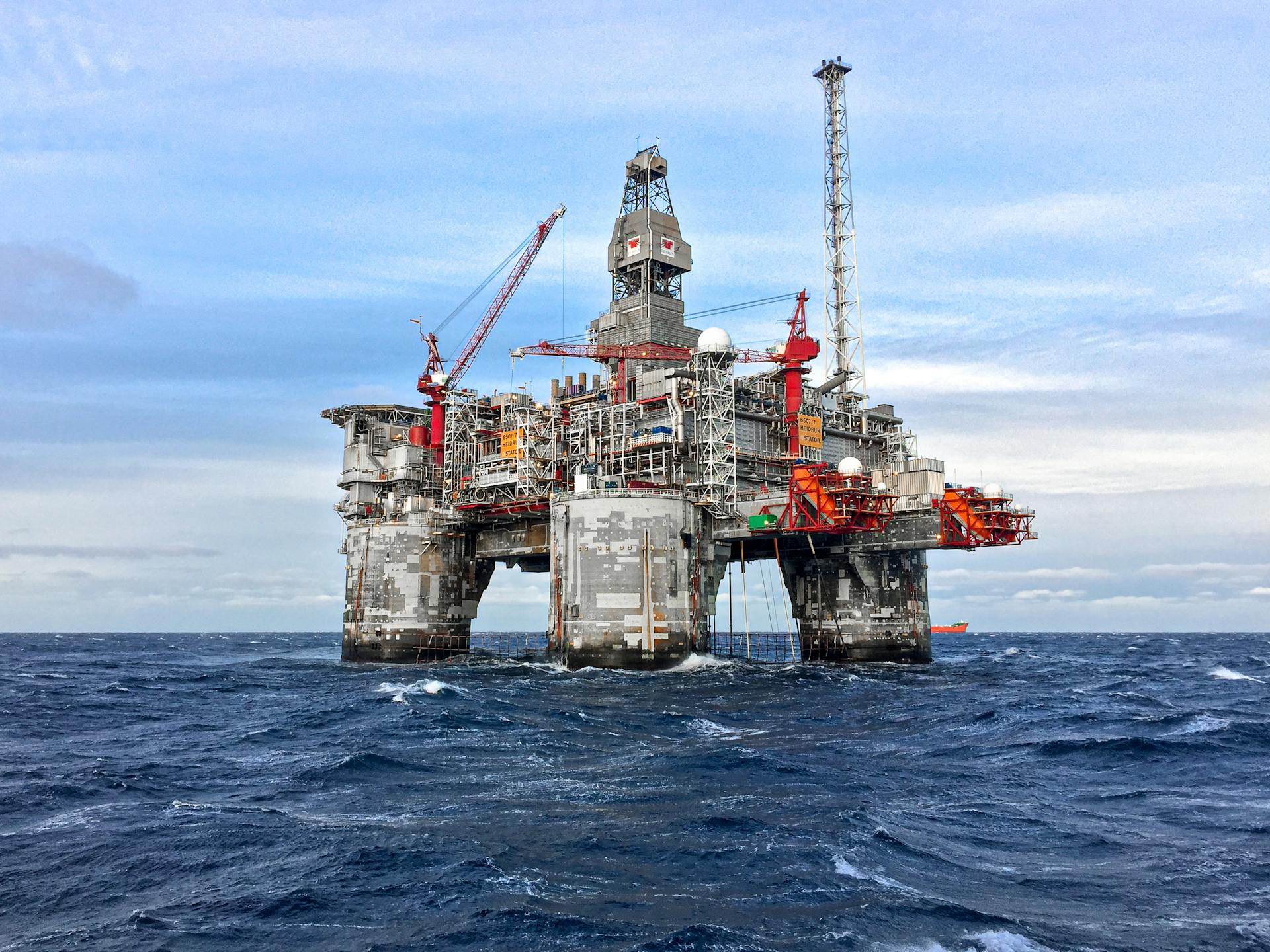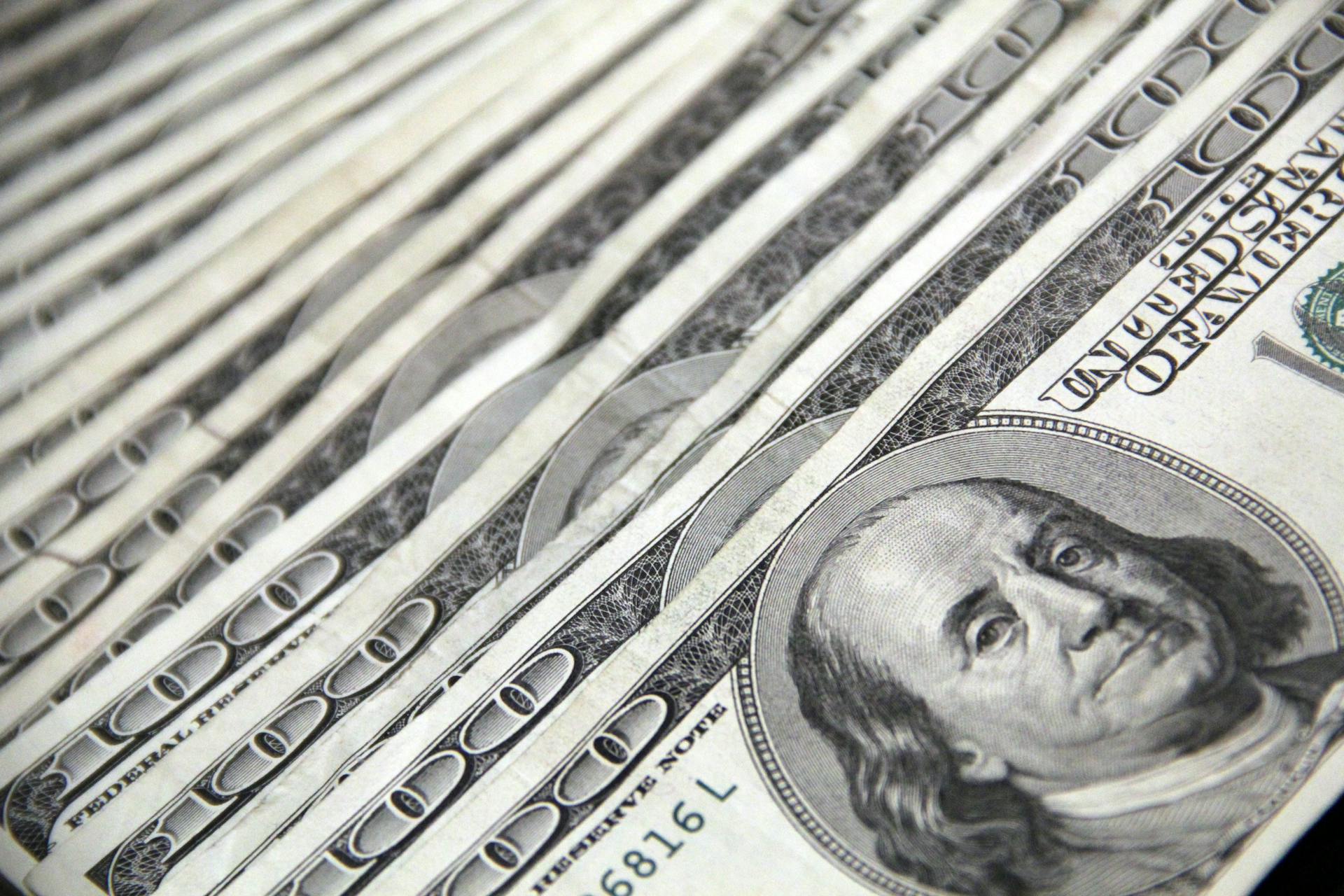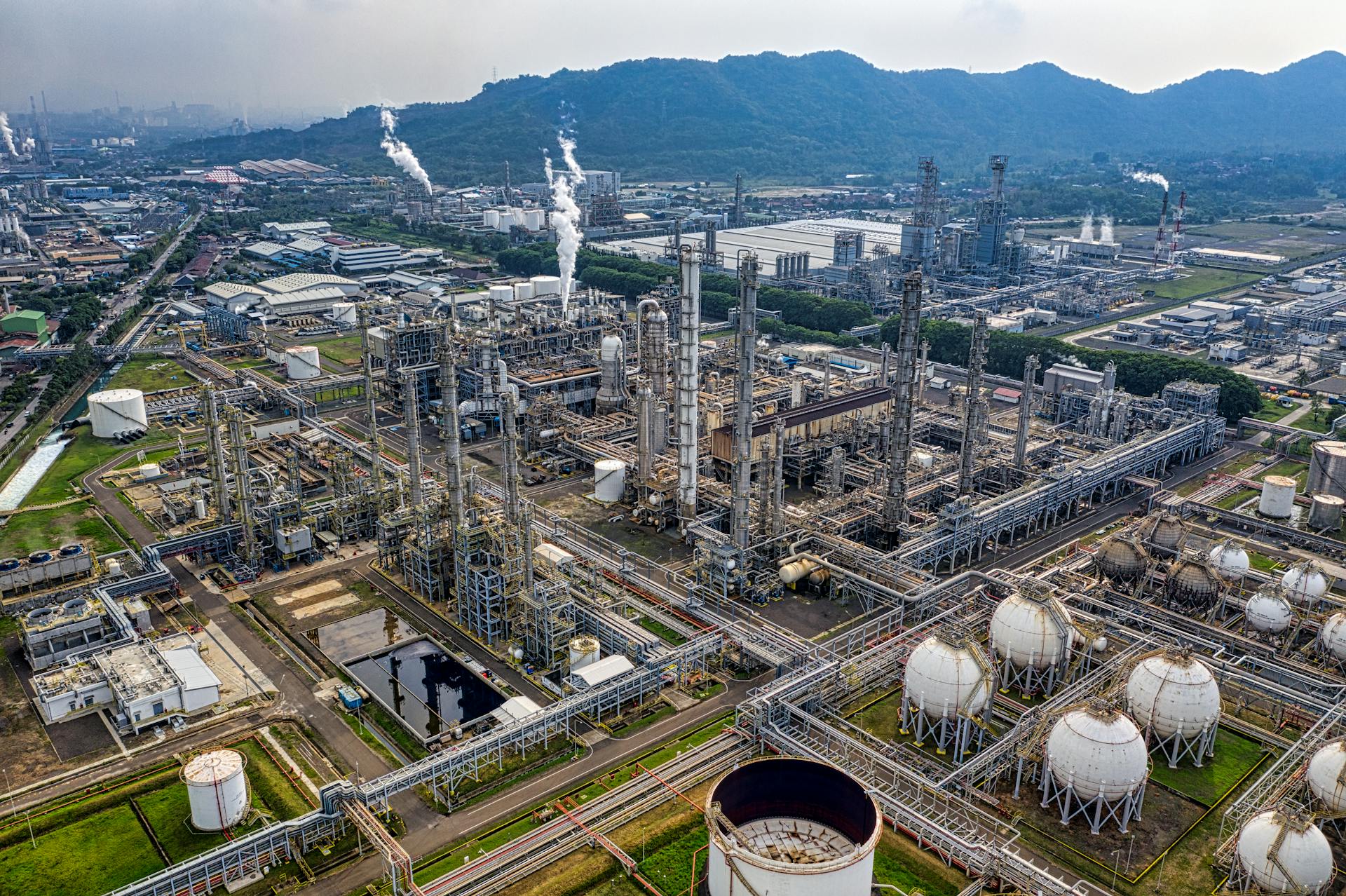
The petrodollar system has been a cornerstone of global finance since the 1970s, but its collapse is now a pressing concern. This system was established as a result of the 1971 Nixon Shock, which severed the link between the US dollar and gold.
The petrodollar system has allowed the US to maintain its economic power by requiring oil-producing countries to price their oil in US dollars. This has given the US a significant advantage in international trade and finance.
The system's collapse would have far-reaching consequences, including a decline in the value of the US dollar and a shift in global economic power. The US has been working to maintain its economic dominance, but its efforts have been met with resistance from other nations.
Suggestion: When Was the Petrodollar Made
History of the Petrodollar
The petrodollar system has a fascinating history that dates back to the 1970s. The origins of the petrodollar system go as far back as the Bretton Woods Agreement, which saw the replacement of the gold standard with the U.S. dollar as the reserve currency.
On a similar theme: Saudi Arabia Not Renewing Petrodollar Agreement
In 1971, President Nixon announced that the greenback would no longer be exchanged for gold, a decision that led to the creation of the petrodollar system. The U.S. and Saudi Arabia agreed to set oil prices in U.S. dollars, making any other country that purchased oil from the Saudi government exchange its currency for U.S. dollars before completing the sale.
The basic framework of the petrodollar system was simple: the U.S. would buy oil from Saudi Arabia and provide the kingdom with military aid and equipment, in return, the Saudis would invest billions of their petrodollar revenue back into U.S. Treasuries. This led other OPEC countries to follow suit and price their oil in U.S. currency.
By 1976, only 6% of global oil was still being transacted in the British pound, down from 20% in 1974. In 1975, Saudi imports of U.S. military equipment had risen from $300 million to over $5 billion.
Here's a brief timeline of the key events that led to the creation of the petrodollar system:
- 1971: President Nixon ends the gold standard, removing the U.S. dollar's backing by gold.
- 1973: The Oil Crisis, triggered by the Yom Kippur War, sees OPEC stop selling oil to the U.S. and allied nations, leading to a surge in oil prices.
- 1973: The U.S.-Saudi Arabia petrodollar agreement is formalized, with Saudi Arabia agreeing to price its oil in U.S. dollars and invest its petrodollar revenue in U.S. Treasuries.
- 1974: The Oil Embargo is lifted, and other OPEC countries follow suit in pricing their oil in U.S. dollars.
The petrodollar system has had a profound impact on global economics and geopolitics, allowing the U.S. to maintain its status as the world's reserve currency and pursue expansionist policies.
Advantages and Disadvantages
The petrodollar has been a game-changer for the US economy, elevating the dollar's standing in financial markets by linking the price of oil to the dollar. This has helped the dollar remain the world's most dominant currency.
The US has been able to finance its account deficit by issuing dollar-denominated assets at very low rates, allowing it to continuously recycle foreign capital.
Advantages
The petrodollar has greatly helped to elevate the U.S. dollar's standing in the financial markets, as the price of oil is linked to the dollar.
This has partly aided the dollar in being the world's most dominant currency, allowing it to finance its account deficit by issuing dollar-denominated assets at very low rates.
The U.S. has been able to wield significant control economically over the globe, thanks to the petrodollar.
Petrodollar recycling means that oil-producing countries end up with surpluses of US currency that need to be "recycled" back into the economy.

The U.S. benefits from this recycling, as it allows foreign capital to flow into the economy.
This has also allowed the U.S. to maintain its friendly relationships with oil-producing countries, such as Saudi Arabia, who have invested their surplus revenues in U.S. government debt.
The U.S. has guaranteed Saudi Arabia's borders, and in return, Saudi Arabia has provided a reliable source of foreign capital for the U.S. government.
Disadvantages
The petrodollar system has its downsides, and they're significant. The US has to run account deficits to maintain its status as the world's reserve currency, which can lead to economic decline if these deficits are stopped.
This creates a Triffin Dilemma, where the US has to balance its own economic needs with the need to maintain the value of the dollar. The system also puts countries like Russia in a difficult position, where they have to deal with a dollarized world market and the US's ability to print money to buy oil.
For your interest: Watch World War

Emerging markets like Mexico have taken on significant dollar-denominated debt, making it hard for them to repay. This has created a web of debt that prioritizes dollar accumulation over domestic investment.
The petrodollar system also gives the US significant political clout, allowing it to impose sanctions on countries it deems as wrong. This has led to countries like Venezuela, Iran, and Russia being subject to expulsion from SWIFT, a major financial network.
The US's dominance through the petrodollar system is so significant that it's been likened to a "company town", where the US asserts its authority through coercion and violence. This has led to the steady growth of the oil and fossil fuels industries at the expense of nuclear power and regional energy independence.
Effects of Large Scale Oil Trading in Eur/Cny
Large scale oil trading in EUR/CNY could have significant effects on the global economy. If countries like Russia, Iran, and Venezuela were to allow the sale of crude oil in other currencies, it could lead to a substantial reduction in USD trades, potentially as high as $255 billion.

This shift would likely result in a strong rebalance in the price of crude oil, increasing its volatility. The price of oil could fluctuate wildly, making it difficult for countries to predict and manage their energy costs.
A decrease in demand for USD would also lead to an increase in interest rates of USD bonds, causing severe budgetary issues for the US. This could be a major blow to the US economy, making it harder for the country to manage its finances.
The US would still require USD to pay interest and principal on its huge USD-based loans, making it difficult to escape the petrodollar's grasp. This would be a major challenge for the US, as it would struggle to pay off its debts.
The shift away from the USD could also significantly decrease the effect of US sanctions, allowing countries to conduct their foreign policy more freely. This could be a major advantage for countries that have been subject to US sanctions in the past.
Recent Events and Crises
The petrodollar wars have had a significant impact on global events. The 1973 oil embargo, sparked by the US support of Israel in the Yom Kippur War, was a major catalyst for the crisis.
The embargo resulted in a sharp increase in oil prices, leading to a global economic downturn. This had a ripple effect on the US economy, with inflation soaring to 11% in 1974.
The US responded by invading Iraq in 1990, in part to protect its oil interests. The Gulf War was a turning point in the petrodollar wars, marking a shift towards US military intervention in the Middle East.
The invasion of Iraq in 2003, under the guise of WMDs, was another example of the US using military force to secure its oil interests. This led to a prolonged and bloody conflict that had far-reaching consequences.
Consider reading: Food Wars
Make Space for Iran
Iran has been making efforts to reduce its dependence on the US dollar in international oil trade. For years, it followed Iraq's lead in pushing for the euro to replace the USD as the currency for international oil trade.
The Iranian Oil Bourse was established in 2008, aiming to trade oil in currencies other than the USD. This move was a significant step towards reducing Iran's reliance on the US dollar.
In 2012, Iran announced that the Bourse would no longer trade oil in USD, which was a major blow to the US dollar's dominance in international oil trade. However, the EU soon followed the US in blocking access to Iranian oil, effectively creating a worldwide embargo.
Despite this setback, Iran continued to pursue its goal of reducing its dependence on the US dollar. After the sanctions were lifted, the country sought to recover tens of billions of USD it was owed by India and other buyers of its oil – but in EUR, not USD.
The 2020 Crisis: Energy
The global energy market was severely impacted by the COVID-19 pandemic, with oil prices plummeting to historic lows.
The pandemic led to a significant decrease in energy demand, resulting in a surplus of oil that drove prices down.
Take a look at this: Gold Prices during War
Oil prices fell by over 60% in the first quarter of 2020, with Brent crude oil prices dropping to around $20 per barrel.
The collapse of the global energy market had far-reaching consequences, including widespread job losses and economic disruption.
Many oil-producing countries, including Saudi Arabia and Russia, were forced to cut production in an attempt to stabilize prices.
The crisis also highlighted the need for a more sustainable and resilient energy system, with a focus on renewable energy sources.
The International Energy Agency (IEA) reported that renewable energy capacity increased by 15% in 2020, despite the pandemic.
This shift towards renewable energy is expected to continue, with the IEA predicting that solar and wind power will account for 30% of global electricity generation by 2025.
Key Players and Agreements
The petrodollar system was a crucial agreement that allowed the US dollar to maintain its global reserve currency status. This was made possible by oil-exporting countries agreeing to sell oil only in US dollars.
Two key players were involved in this agreement: Saudi Arabia and the United States. Saudi Arabia was a major oil producer, and the US was desperate for a solution to maintain its global economic influence.
The US needed to secure a steady supply of oil and a way to fund its ongoing deficit spending. Saudi Arabia's oil revenue was reinvested in US government debt, providing the necessary funds for the US to continue deficit spending.
Here's a list of key players involved in the petrodollar system:
- Saudi Arabia: major oil producer and key player in the petrodollar system
- United States: beneficiary of Saudi oil revenue and maintainer of global reserve currency status
China-Russia Agreement
China and Russia have formed a significant agreement in the oil trade. China's crude oil imports have increasingly come from countries outside the OPEC, making up 65% of the growth in China's crude imports between 2012 and 2016.
In 2012, Saudi Arabia held a 20% share of Chinese crude imports, while Russia trailed behind with around 7%. However, by May 2017, Russia became the main exporter of oil to China.
Expand your knowledge: Russia Win
This shift is significant, as it marks a decline in Saudi Arabia's share of Chinese crude imports, with shipments down over 15% year-over-year. Russia now occupies the 1st position, with 1.35 million barrels per day (bpd) of oil exports to China.
The agreement is also closely tied to China's efforts to establish the yuan as a reserve currency. The yuan-denominated crude oil futures contracts, backed by gold, have been introduced on the Shanghai and Hong-Kong exchanges.
These contracts bring a stable confidence frame to support the new Asian oil benchmark, which will begin trading on the Shanghai International Energy Exchange (INE) later this year. This is a major step towards establishing an alternative to the US dollar as the global reserve currency.
Key Players and Agreements
The petrodollar system has played a significant role in maintaining the U.S. dollar's global reserve status. Saudi Arabia has been a key player in this system.

The U.S. and Saudi Arabia agreed to a deal in the 1970s where Saudi Arabia would sell its oil only in U.S. dollars. This deal boosted the dollar's global reserve status.
Saudi Arabia's oil revenue was reinvested in U.S. government debt, enabling the U.S. to continue deficit spending. This has been a crucial aspect of the petrodollar system.
Saudi Arabia is now accepting other currencies for oil, marking the end of the petrodollar monopoly. This shift is a significant development in the global economy.
The BRICS nations are developing a new currency to further undermine the dollar's global dominance. This move is a response to the changing global economic landscape.
Here are the key players involved in the petrodollar system:
- Saudi Arabia
- United States
- BRICS nations
System Collapse
The petrodollar system is a complex web of international trade and finance that's been the backbone of the global economy for decades. The US dollar's status as the world's reserve currency is a key component of this system.
The dollar's value is artificially propped up by the US government's ability to print more money, which can lead to inflation and devaluation of the currency. This has happened several times in the past, with the most notable example being the 1970s oil embargo.
The 1970s oil embargo was a turning point for the petrodollar system, as it led to a significant increase in oil prices and a corresponding increase in the value of the dollar. This was a temporary solution, as the long-term effects of the embargo were devastating to the global economy.
The US government has maintained control over the global economy by using its military might to enforce the petrodollar system. This has led to numerous wars and conflicts, including the Gulf War and the Iraq War.
Suggestion: War Nickel Value Chart
Frequently Asked Questions
What happens if petrodollar dies?
If the petrodollar dies, the US dollar's status as the global reserve currency could weaken over time, potentially leading to more rapid de-dollarization
Is Saudi Arabia dropping the petrodollar?
There is no confirmed evidence that Saudi Arabia is dropping the petrodollar arrangement, but speculation about a potential overhaul of its oil-pricing policy exists. The status of this arrangement remains unverified.
Sources
- https://magnuscmd.com/the-end-of-the-petrodollar/
- https://finfoc.com/are-we-seeing-the-collapse-of-the-petrodollar-system/
- https://www.birchgold.com/blog/finance/petrodollar-collapse/
- https://www.eurasiareview.com/01072024-the-implications-of-the-non-renewal-of-the-petrodollar-system-oped/
- https://mises.org/mises-wire/saudi-arabias-quandary-end-petrodollar
Featured Images: pexels.com


